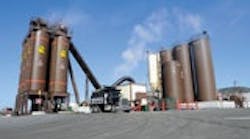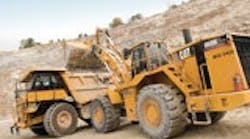Q. Why have you doubled the number of service trucks from four to eight over the past 10 years?
A. "We had an outside vendor servicing one region, but we felt we had better control if we did it ourselves," says Jim Maurer, equipment manager for New Enterprise Stone & Lime Co. "We're spread out more geographically now, and we're able to hit the [service] intervals with it in-house."
Maurer cites improved machine technologies and warranty requirements for the move, the cost of which will be recouped within five years. The investment is already paying off, however, in better on-time performance of preventive maintenance, increased uptime, and longer component life.
The last two trucks were added in 2000 and 2001, and uptime has increased by 20 percent since then. Over the past 10 years, uptime has risen by 30 percent, Maurer says. "Our eight field lube trucks service all our off-road equipment," he says. "Three trucks are currently on two-shift operation; the rest are on daylight operation."
The fleet totals more than 2,900 pieces, and two-shift operation has enabled New Enterprise to improve on-time performance of lube service by 25 percent. "Hitting intervals affects the warranty," Maurer says. "It was a struggle during the daylight shift to get a piece of equipment away from the crew so we could service it. They didn't care if it was 500 hours overdue for service." Crews are now more efficient in the field because they have more productive machines, he says.
The impact of on-time servicing is seen in longer component life. "If you always hit the standard 250-hour interval, you don't have the buildup of carbon in the oil that you would see if you went to 400 or 450 hours," says Maurer. Of course, missed intervals build on each other, too. If the 250-hour call is missed, more-involved service such as hydraulics and transmission are pushed back.
"Transmission life has increased by 40 percent simply because we're servicing on time and sampling," Maurer says. "Hydraulics is the same. We've seen an increase in life, plus a decrease in the amount of hydraulic fluids we're using, simply because we're maintaining systems better than we had in the past."
Improved maintenance coupled with improved engine technologies has helped stretch engine life, too, Maurer says. "Before electronic engines, we'd get 8,000 hours if we were lucky. Today we're running E-engines to 16,000 before we even think of pulling them. Technology and maintenance have given us this increase in life."
New technology has brought with it more warranty requirements, which makes PM intervals critical to keeping the warranties valid. "If there's ever a question on a failed component, you always have your records to show that everything's been punctually serviced," Maurer says.
This, he says, is one reason for the newer truck bodies. "We're carrying more products because of the requirements to keep up with warranties. When dealing with a Cat warranty, you need to deal with the oils that Cat is recommending for the cavities in their machines. You may have one lube for a Cat; you may have another spec for a Hitachi. We have different makes and models of equipment at different locations, so we would have two hydraulic fluids, two engine oils, two transmission oils."
New Enterprise's older service trucks were not equipped to handle the increase in service products, so Maurer specified the new truck bodies to be able to carry those eight products, as well as an air compressor, coolant and grease.
The two new trucks cost $170,000 each: Peterbilt chassis ran $90,000; IMT lube bodies cost $80,000 equipped. In addition, Maurer has retrofitted the six older service trucks with additional tanks, allowing them to carry all eight products. Retrofits cost $10,000 for each truck. The cost of the new and retrofitted field lube trucks will be recouped within five years, Maurer says.
Maintenance has become more important as life expectancies of machines have increased, and that's the reason behind the changes in service trucks, Maurer says. "It's all about the longevity of the initial investment."







